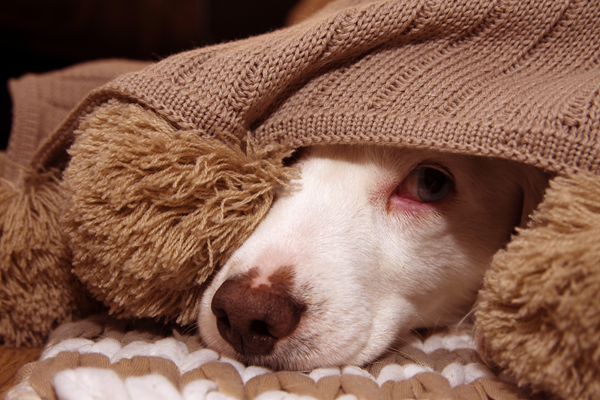
It’s heart-wrenching to have to watch your pet experience fear during a noisy thunderstorm or chaotic fireworks night. It is emotionally exhausting on them and you, too!
These phobias are unfortunately relatively common, but as we learn more about them, you can help your pet manage them better.
Understanding the Fear: Why It Happens
Loud noises and sudden flashes are unpredictable and can be overwhelming. Since dogs and cats have heightened sensitivity to sound, smell, and sensation, a boom of thunder or firework explosion can feel like an attack.
Phobias often develop from:
- Lack of early exposure to these types of noises during important periods of development
- Genetics – some breeds are more likely to develop phobias than others
- Previous trauma, like being alone or outside when a scary storm occurs
- Increased sensitivity to bright light, changes in barometric pressure, or vibrations
Over the years, anxiety can intensify, resulting in phobia development.
Signs of Anxiety
Pets can’t tell you they’re scared, but if you watch their behavior, you might see:
- Pacing, panting, trembling
- Whining, barking, meowing more than usual
- Hiding or looking for small spaces to hide
- Destructive behavior or trying to escape
- Clinginess
- Loss of appetite or unexpected urinary or fecal accidents
Cats may freeze, disappear, or try to get outside. Dogs might try to dig through doors or escape from their yard. They are not being disobedient; they’re in panic mode.
- Don’t punish them or force them out of hiding, as doing so can increase fear and may result in aggression.
- Offer comfort, treats, and calm reassurance, but don’t fuss over them.
How to use Compassion to Help
An anxious pet needs patience, empathy, and often more than one method of assistance.
Retrain Emotional Responses (Behavior Modification):
- Desensitization: Start by teaching your pet to “settle” on a mat to promote relaxation. Then gradually expose your pet to the scary sound, starting at very low volumes, and only increasing the volume if your pet stays calm.
- Counterconditioning: While exposing your pet to the sound, give them a positive experience, like a favorite treat or toy.
Calming Environment:
- Play calming music.
- Use white noise.
- Reduce visible stimulation: close the curtains or move to an inside room.
Compression Clothing, Pheromones, and Supplements:
- Some pets respond to compression wraps that provide gentle pressure, mimicking the feeling of being swaddled.
- Dog appeasing pheromone diffusers and sprays can reduce the fear response.
- Supplements can also have a calming effect, including those that contain casein, tryptophan, melatonin, and L-theanine. Always check with your veterinarian to ensure a supplement is safe to give to your pet.
Medications:
- Pets with severe phobias often need anti-anxiety medication.
- Usually a combination of medications are used: one medication is taken every day and another, fast-acting medication can be given just before or during a scary event.
Professional Help:
- Just like many people need trained therapists to help them with anxiety conditions, you may need to work with a veterinary behaviourist or Fear Free certified professional to help your pet.
Preparing for the Scary Season
- If possible, work on desensitization and counterconditioning in the “quiet” season.
- Create a safe, calming space in your home.
- Talk to your veterinarian about supplements and medications that can help your pet.
- Plan for your pet to stay somewhere quiet during fireworks celebrations – don’t take them to see the fireworks.
- Ensure microchip information is accurate in case they do escape.
You’re Not Alone
Caring for a pet with phobias can feel frustrating and emotionally exhausting. But with knowledge, patience, and professional support, progress is possible. Every step you take to help your pet feel safe brings you closer to a calmer, happier life together.
So next time the skies light up or thunder rumbles, you’ll be ready — with compassion, a toolkit of strategies, and the strength of your bond.






